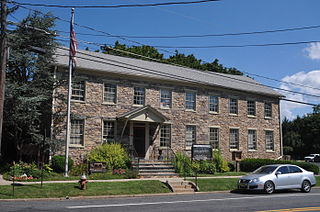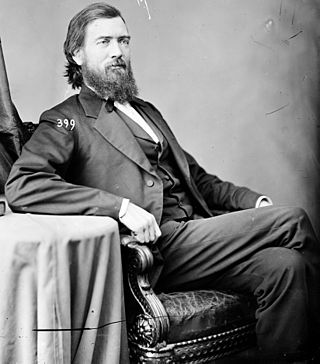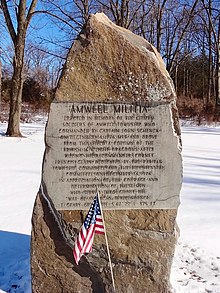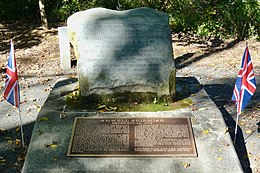
Hunterdon County is a county located in the western section of the U.S. state of New Jersey. At the 2020 census, the county was the state's 18th-most populous county, with a population of 128,947, its highest decennial count ever and an increase of 598 (+0.5%) from the 2010 census count of 128,349, which in turn reflected an increase of 6,360 (5.2%) from the 121,989 counted in the 2000 census. Its county seat is Flemington. The county is part of the Central Jersey region of the state.

Route 31 is a state highway in New Jersey, United States. It runs 48.93 mi (78.75 km) from U.S. Route 1 Business /US 206 in Trenton, Mercer County, north to an intersection with US 46 in Buttzville in White Township, Warren County. Along the way, Route 31 heads through the communities of Flemington, Clinton, and Washington. Most of the highway is state-maintained; however, the section within the city limits of Trenton is maintained by the city. Much of Route 31 is a two-lane highway that passes through farmland, woodland, and mountainous areas. Two portions of the route—from Trenton to Pennington and from Ringoes to Clinton—consist of more development.

Delaware Township is a township in Hunterdon County, in the U.S. state of New Jersey. Part of the township is on the Hunterdon Plateau, while the southern portions are in the Amwell Valley. As of the 2020 United States census, the township's population was 4,560, a decrease of three people (−0.1%) from the 2010 census count of 4,563, which in turn reflected an increase of 85 (+1.9%) from the 4,478 counted in the 2000 census.

East Amwell Township is a township in Hunterdon County, in the U.S. state of New Jersey. As of the 2020 United States census, the township's population was 3,917, a decrease of 96 (−2.4%) from the 2010 census count of 4,013, which in turn reflected a decline of 442 (−9.9%) from the 4,455 counted in the 2000 census.

Flemington is a borough in and the county seat of Hunterdon County, in the U.S. state of New Jersey. Most of the borough is located in the Amwell Valley, a low-lying area of the Newark Basin, and the Raritan Valley, the South Branch of the Raritan River, which flows through the center of Flemington. Northwestern portions of the borough sit on the Hunterdon Plateau. As of the 2020 United States census, the borough's population was 4,876, its highest decennial count ever and an increase of 295 (+6.4%) from the 2010 census count of 4,581, which in turn reflected an increase of 381 (+9.1%) from the 4,200 counted in the 2000 census.

Raritan Township is a township in Hunterdon County, in the U.S. state of New Jersey. As of the 2020 United States census, the township's population was 23,447, an increase of 1,262 (+5.7%) from the 2010 census count of 22,185, which in turn reflected an increase of 2,376 (+12.0%) from the 19,809 counted in the 2000 census. The township is located within the heart of the Amwell Valley and Raritan Valley regions, as the South Branch of the Raritan River flows through the center of the township. The northwestern portion of the township is located on the Hunterdon Plateau.

West Amwell Township is a township in Hunterdon County, in the U.S. state of New Jersey. As of the 2020 United States census, the township's population was 3,005, a decrease of 835 (−21.7%) from the 2010 census count of 3,840, which in turn reflected an increase of 1,457 (+61.1%) from the 2,383 counted in the 2000 census.

John Hart was an American Founding Father and politician in colonial New Jersey. As a delegate to the Continental Congress, Hart signed the Declaration of Independence. He died several years before the end of the Revolutionary War while still active in patriotic efforts.

Charles Stewart was an officer during the American Revolutionary War and a Continental Congressman.
The Flemington-Raritan Regional School District is a comprehensive regional public school district in eastern Hunterdon County, in the U.S. state of New Jersey, which serves students in pre-kindergarten through eighth grades from the neighboring communities of Flemington Borough and Raritan Township.

Hunterdon Central Regional High School is a comprehensive, four-year public high school, and regional school district that serves students from five municipalities in east central Hunterdon County, in the U.S. state of New Jersey. Students from Delaware Township, East Amwell Township, Flemington, Raritan Township and Readington Township attend the school. It is the district's only school.
Amwell Township was a Township that existed in Hunterdon County, New Jersey, United States, from 1708 to 1846.

John Schenck (1750–1823) was a captain in the New Jersey Militia during the American Revolutionary War.

The Forage War was a partisan campaign consisting of numerous small skirmishes that took place in New Jersey during the American Revolutionary War between January and March 1777, following the battles of Trenton and Princeton. After both British and Continental Army troops entered their winter quarters in early January, Continental Army regulars and militia companies from New Jersey and Pennsylvania engaged in numerous scouting and harassing operations against the British and German troops quartered in New Jersey.
The Delaware Township School District is a community public school district that serves students in pre-kindergarten through eighth grade from Delaware Township, in Hunterdon County, in the U.S. state of New Jersey.

John Taylor Bird was an American politician and businessman who represented New Jersey's 3rd congressional district for two terms from 1869 to 1873.
The East Amwell Township School District is a community public school district that serves students in pre-kindergarten through eighth grade from East Amwell Township, in Hunterdon County, in the U.S. state of New Jersey.
John Manners was an American physician, lawyer, and politician who served as President of the New Jersey Senate.
John Mott was a captain in the 1st Hunterdon Regiment of the New Jersey militia during the American Revolutionary War. He served as a guide to General George Washington and the Continental Army during their march down along the Delaware River prior to the Battle of Trenton.

Abraham Hunt (1741–1821) was a wealthy American merchant and farmer in Trenton, New Jersey, first Postmaster of Trenton, and served in the American Revolutionary War as a Lieutenant Colonel in the Hunterton County militia. He was a prominent member of the First Presbyterian Church in Trenton. Early in the revolution he was a member of the Provincial Congress that held some of its sessions in Trenton. He played the host and placated the German Hessian commander Johann Rall before the Battle of Trenton. Suspected of duplicity for his accommodation to the Hessians, Hunt was charged with treason, but was acquitted and went on to serve in the cause for American independence. After the war, Hunt became involved in the politics and business interests of Trenton and New Jersey overall.


















